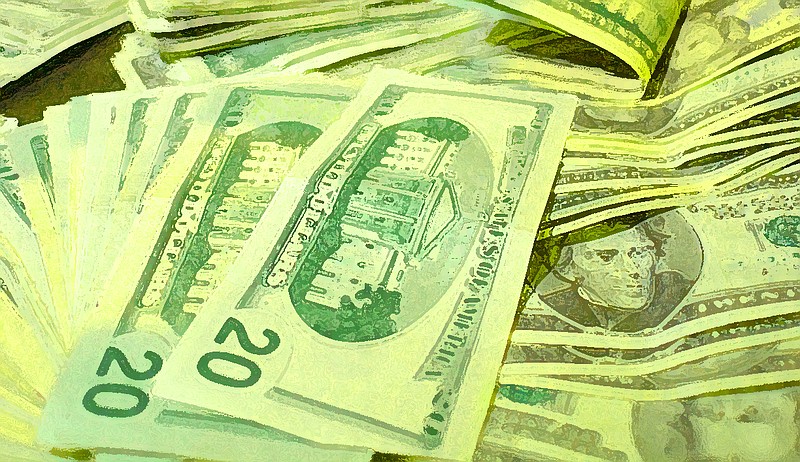WASHINGTON -- Consumer prices in the United States jumped 2.6% in March compared with the same month last year, fueled by an economy that has strengthened since last spring, when the coronavirus pandemic threw the country into desperate straits.
The federal government's consumer price index, which measures the change in what customers pay for goods and services such as groceries, clothing and gasoline, increased by 0.6% from February to March, the Labor Department said Tuesday. But U.S. officials have stressed that even though inflation is ticking upward, the changes probably will be short-lived as parts of the economy normalize in the wake of the pandemic.
The latest figures came in slightly higher than economists had expected, with projections at 2.5% for the past year and 0.5% month to month.
Investors shrugged off the price data -- stocks were mixed and bonds were little-changed -- and focused instead on news that U.S. health officials have called for a pause on the use of Johnson & Johnson's covid-19 vaccine because of blood-clotting concerns.
"It was a bit stronger than the official consensus expectations, but it was lower than some people were worried about," Matt Maley, chief market strategist for Miller Tabak + Co., said about the consumer price index report. When combined with the Johnson & Johnson news, "it means that the Fed can probably continue to provide plenty of stimulus going forward," he said.
The jump in prices highlights the drastic changes to the economy from a year ago, when the pandemic unleashed havoc on consumers, businesses and suppliers and compelled the White House and Congress to authorize emergency spending to tackle the crisis. This year, health workers have administered millions of vaccine doses, and the Biden administration continues to roll out coronavirus relief packages.
But the federal government's huge spending programs have drawn criticism from some market analysts and Republican lawmakers who have raised concerns about overspending and overstimulating the economy. The hundreds of billions of dollars in relief, they say, could trigger long-feared inflation, an argument that critics might amplify after Tuesday's data release.
The Federal Reserve and the White House, however, have pushed back against those arguments, anticipating the uptick in prices. In a blog post on Monday, White House officials said they expect inflation to increase somewhat but that they believe the main factors driving those upticks, including pent-up demand and supply chain disruptions, will subside over time as businesses regain their footing.
The officials predict that after several months of a modest rise, inflation will fade "back to a lower pace thereafter as actual inflation begins to run more in line with longer-run expectations."
In a direct reference to the consumer price index, the officials also noted that the sudden disruptions from last spring will distort annual comparisons, since prices dropped so drastically last year when the coronavirus first took hold of the economy. They predict that as more time passes after the worst economic period of the pandemic, the spikes in price data should flatten.
Despite a surge in hiring and a strengthening economy, Fed officials maintain that the job market is still in rough shape for millions of Americans. The number of people who have been unemployed for more than six months remains above 4.2 million, up from more than 1 million before the pandemic.
The Fed now expects inflation to hit 2.4% this year, up from an earlier estimate of 1.8%, but the persistence of unemployment has pressured central bankers not to ease up on emergency measures to repair the economy.
During an interview Sunday on CBS News' "60 Minutes," Fed Chairman Jerome Powell said the central bank will not raise interest rates, in an attempt to tamp down the economy, until inflation is moderately above the Fed's target rate for a period of time. "We don't mean just tap the base once," he said. "We want it to be just moderately above 2%. So that's what we're looking for."
Economists said they expect further price gains in the coming months as the country continues to open up, but they believe the Fed will continue to see those gains as temporary.
"The surge in inflation in March is the first meaningful wave of several that will cumulatively lift inflation in the coming months to a level not seen in many years," said Jim Baird, chief investment officer for Plante Moran Financial Advisors. "Even so, the coming surge shouldn't be a cause for alarm."
Rubeela Farooqi, chief U.S. economist at High Frequency Economics, said price pressures will build further over the next few months, reflecting a variety of factors that include supply chain restraints and stronger demand as economic activity resumes. But she said the Fed will view these price increases as transitory and "not expected to be sustained."
The report Tuesday showed that new-vehicle prices were unchanged in March and were up 1.7% over the past year while used-car prices rose 0.5% and were 9.4% higher than a year ago.
For March, energy prices increased 5%, led by a 9.1% jump in gasoline prices. The gasoline surge accounted for nearly half of the monthly price gain. AAA reports that the nationwide average for gasoline stands at $2.86 a gallon, up from $1.86 a year ago.
Food prices edged up 0.1% in March and were 3.5% higher than a year ago.
Information for this article was contributed by Hamza Shaban and Andrew Van Dam of The Washington Post; by Reade Pickert of Bloomberg News; and by Martin Crutsinger of The Associated Press.
